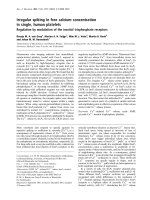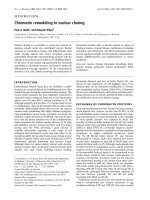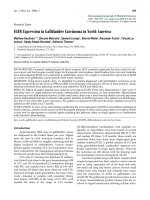Báo cáo y học: "Terrorist bombings in Madrid" potx
Bạn đang xem bản rút gọn của tài liệu. Xem và tải ngay bản đầy đủ của tài liệu tại đây (33.1 KB, 3 trang )
20
GMUGH = Gregorio Marañón University General Hospital.
Critical Care February 2005 Vol 9 No 1 Frykberg
The report by Peral Guiterrez de Ceballos and colleagues [1]
is a timely, well written, and informative contribution to our
growing body of knowledge of disaster medicine, as well as
an appalling confirmation of the horrors of the senseless and
vicious scourge of terrorism that now afflicts the world. Their
comprehensive analysis of the results of medical
management of 312 survivors triaged to the Gregorio
Marañón University General Hospital (GMUGH) provides
several important lessons, and raises several questions, for
medical providers around the world who are increasingly
faced with the necessity of learning how to plan and
implement an effective response to such a daunting
challenge.
The authors confirmed the many consistent patterns to be
expected following terrorist bombings, which virtually every
other published series has documented [2,3]. The great
majority of immediate survivors (1789/1885 [95%]) were not
critically injured. As the authors state, this is best explained
by the selection bias caused by the immediate death of most
of those with critical injuries. Although it appears quite
favorable that 14 of these 1885 immediate survivors (0.74%)
subsequently died, it is important to recognize that this is
deceptive because most casualties were not at all at risk for
death. The death rate was correctly expressed in this report
as a percentage of only the critically injured casualties who
were truly at risk for death, and among whom all deaths
occurred, resulting in a much heftier ‘critical mortality’ rate of
17% (14/82). This is a more accurate reflection of the quality
of medical care given in such a mass casualty setting, and is
a more accurate standard for comparison with other similar
bombings. This critical mortality rate falls well within the
range of all other terrorist bombing disasters, and lends itself
to quality improvement analysis. The authors should be
commended for applying the established objective measures
of injury severity (Injury Severity Score, Acute Physiology and
Chronic Health Evaluation II) to their patient population to
allow this determination. I do agree that the two early
emergency room deaths should be included in this figure
because these patients were exposed to medical care.
The injury patterns in this event were also typical of bombing
disasters. Head, chest, abdominal, traumatic amputation and
blast lung injuries predominated among the critically injured
survivors, being the most common contributors to death;
musculoskeletal and soft tissue wounds predominated
among those who were not critically injured. Eardrum
perforations and eye injuries were quite common but did not
cause life-threatening problems.
Over-triage, or the assignment of noncritically injured victims
to immediate medical evaluation and hospitalization, was also
predictably and typically high, in view of the large load of
casualties with noncritical injuries. At the GMUGH, 91 out of
the 312 survivors evaluated (29%) were hospitalized, but 62
of these were not critically injured, yielding a substantial over-
triage rate of 68%. The danger with this degree of over-triage
is in the potential to overwhelm limited medical resources
and prevent that minority with critical injuries from being
quickly identified and treated, thus increasing critical
mortality. Although the authors did not believe that this
interfered with their treatment, their 17.2% critical mortality at
this level of over-triage falls well within the linear relationship
demonstrated between over-triage and critical mortality [3].
Furthermore, an objective analysis of the deaths may reveal
preventable delays in diagnosis and treatment that were not
immediately perceived. For instance, one of the deaths was
due to a ruptured thoracic aorta in a patient who had been
fully evaluated and already admitted to the intensive care unit;
could this injury have been identified earlier and repaired, and
could it represent an oversight caused by the confusion of
sorting out so many noncritical victims? These considerations
Commentary
Terrorist bombings in Madrid
Eric R Frykberg
Professor of Surgery, University of Florida College of Medicine, Jacksonville, Florida, USA
Corresponding author: Eric R Frykberg,
Published online: 3 November 2004 Critical Care 2005, 9:20-22 (DOI 10.1186/cc2997)
This article is online at />© 2004 BioMed Central Ltd
See Review, page 104
21
Available online />emphasize the importance of triage accuracy, and of
preventing, as much as possible, the arrival of so many
noncritical victims to a definitive care hospital by performing
triage first at outside sites before allowing them to inundate
the hospital.
The massive response of the public to donate blood
following the Madrid bombings is another very typical pattern
seen in such disasters. However, it is a very unfortunate
response that represents a misguided attempt to help on the
part not only of the lay public but also of the medical
community and media, and must be curbed in future events.
It is well established that very little blood is needed in these
disasters; again, only a small minority are critically injured,
and only a small percentage of these ever need blood.
Following the New York City World Trade Center disaster of
9/11, more than 20,000 units of donated blood had to be
discarded unused. This was confirmed by the authors of this
paper in reporting only 104 units given to patients out of
several thousand donated units. The problem with this is that
the hospital can be paralyzed by the crowds lining up to give
blood, diverting critically scarce hospital resources and
personnel away from those victims who are most in need,
leading to potentially unnecessary harm to these victims. This
altruistic response of the public should be more effectively
channeled to other blood-banking facilities outside hospitals
where they will not interfere with triage and treatment of
casualties, and the media should be educated to avoid
directing the public to such futile activity.
Nonetheless, the outstanding performance of the authors,
their coworkers, and the entire city of Madrid in the hours and
days following this tragedy must be recognized. There
appeared to be a reasonably prompt and effective initial
triage and distribution of casualties among all available
hospitals by the prehospital first responders, indicated by the
fact that GMUGH – the closest facility – was not inundated
with the majority of casualties, as has occurred in so many
other similar events. The most seriously injured were
apparently transported to the most appropriate hospitals with
the greatest resources. With virtually no warning, GMUGH
performed all of the appropriate procedures to maximize their
surge capacity for incoming victims (clearing of emergency
room, intensive care unit and floor beds, and canceling all
surgery in the operating rooms); this is a valuable lesson, and
all hospitals should include such actions in their disaster
plans. The absence of any apparent under-triage – deaths
due to critical injures being overlooked and assigned to
delayed care – suggests good triage and is quite consistent
with the published literature. The high number of blast lung
injuries in survivors also suggests rapid evacuation and
treatment, and the low mortality (2/17 [12%]) among these
survivors indicates excellent intensive care for such very
difficult cases. The relatively low immediate death rate of
8.6% (177/2062), as compared with most other terrorist
bombings, is certainly due in part to the fact that this was an
open air blast that was rapidly dissipated over a short
distance, without any building collapse or shrapnel causing
serious penetrating wounds. However, the rapid response,
and evacuation and treatment of survivors who otherwise
may have died with longer delays could undoubtedly be
another contributing factor to this result.
The authors discuss the merits of developing a trauma
system in Spain to augment and serve as the basis for
disaster readiness on a large scale, a concept that we
advocate in the USA [4]. Trauma centers have a ready-made
infrastructure in place for disaster responses, including the
personnel and resources for managing multiply injured
patients in large numbers. They also have most of the
necessary liaisons with public health, law enforcement, the
media, prehospital services, search and rescue, local
government, and transportation assets for evacuation. Most
importantly, they have around-the-clock surgical availability.
This is essential in those terrorist attacks that are, by far, the
most likely to occur if we are to heed history as well as
current events, namely bombings and shootings, with bodily
injury the most likely result. In fact, a state-wide system has
already been implemented on this principle in Connecticut,
using the state-wide trauma centers in a coordinated network
of function, which serves as a model of what can be done in
any region or country [5].
There are several cogent questions that remain unresolved
with this report, but only a full analysis of the entire event,
looking at the combined experience of all involved hospitals,
can answer these. All 14 deaths among the critically injured
survivors should be thoroughly analyzed to identify any
preventable problems in management that could be improved
in future events. Were there any hospitals in Madrid that were
not used, which could have helped to lighten the load on the
others? If so, then a better system of casualty distribution
should be planned. It would be of interest to know how the
existing disaster plan of GMUGH, and for the entire city of
Madrid, held up through this event. Was it at all helpful?
Were any revisions made as a result of this experience to
improve the disaster response in the future? It has been
recommended by several experts that the closest hospital to
the disaster scene, as GMUGH was, should be used as a
casualty collection point and initial triage station for
distribution of casualties to the other available hospitals,
rather than as just another treatment facility, as it was in this
event. What led to this decision? What procedures were
used to assure security of the hospital and prevent it from
being overrun with worried well victims and families, and how
was the media handled? These considerations are important
points for all of us to learn.
Finally, the authors must be congratulated for their foresight
and commitment in performing the huge but essential task of
putting together all these data and submitting a report for
publication so that the rest of the world can learn from their
22
Critical Care February 2005 Vol 9 No 1 Frykberg
valuable experience. Unlike most of medicine, true mass
casualty disasters are very rare, and approaches to planning
and management are very different from our everyday
practice. Therefore, most of us will never learn how to deal
with such incidents, and the same mistakes will be repeated
each time unless we take to heart the experiences of those
who have been confronted with a disaster. With the wealth of
published experience now available to us, which this reports
nicely augments, it is clear that there are definite patterns of
injury, behavior, and impediments to care that follow all
terrorist bombings, and – to a great extent – disasters of all
kinds as well. Once patterns are identified, there is
opportunity to plan and cope, and discard the notion that
these are acts of God that cannot be predicted or planned
for. The biggest barrier to effective learning now is the apathy
and complacency that plagues so much of our medical
community, precisely because of the rarity of these events.
We must all become involved in disaster planning at our own
hospitals and in our own communities, and contribute to the
education and motivation of our colleagues if success is to
be achieved.
Competing interests
The author(s) declare that they have no competing interests.
References
1. Peral Gutierrez de Ceballos J, Turégano-Fuentes F, Perez-Diaz D,
Sanz-Sanchez M, Martin-Llorente C, Guerrero-Sanz JE: 11 March
2004: The terrorist bomb explosions in Madrid, Spain – an
analysis of the logistics, injuries sustained and clinical man-
agement of casualties treated at the closest hospital. Crit
Care 2005, 9:104-111.
2. Frykberg ER, Tepas JJ: Terrorist bombings: lessons learned
from Belfast to Beirut. Ann Surg 1988, 208:569-576.
3. Frykberg ER: Medical management of disasters and mass
casualties from terrorist bombings: how can we cope? J
Trauma 2002, 53:201-212.
4. Jacobs LM, Goody M, Sinclair A: The role of a trauma center in
disaster management. J Trauma 1983, 23:697-701.
5. Jacobs LM, Burns KJ, Gross RI: Terrorism: a public health
threat with a trauma system response. J Trauma 2003, 55:
1014-1021.









